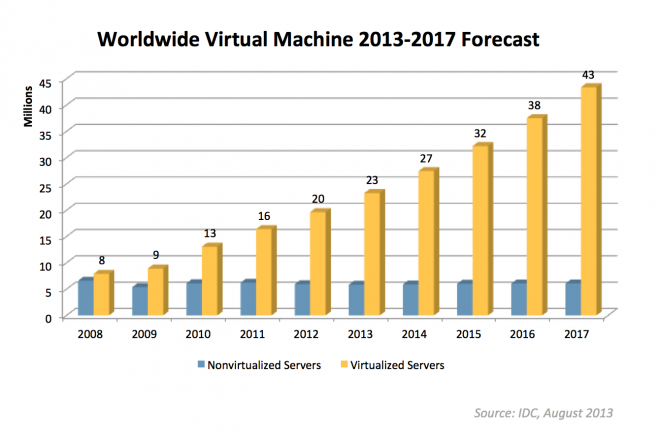- VOX
- Technical Blogs
- Protection
- Better Backup for VM Sprawl
Better Backup for VM Sprawl
- Subscribe to RSS Feed
- Mark as New
- Mark as Read
- Bookmark
- Subscribe
- Printer Friendly Page
- Report Inappropriate Content
Better Backup for VM Sprawl
The following chart is data from IDC data:

Two things immediately stand out when looking at this data: 1) VM growth is going to continue into the predicted future (not surprising), and 2) physical server presence is constant over the same time frame (also not suprising).
As organizations increase their use of virtualization technology, lower time-to-provision drives ever-faster rates of virtual server growth. As the number of servers multiplies, the challenge of protecting these systems grows in proportion.
What’s interesting to me is that the battle we find ourselves in today, with a single-solution to protect both physical and virtual vs. separate solutions for physical and virtual will still be raging in the future. The biggest difference though is that in the future, there’ll be many more virtual machines than there are today.
Scalability
When we think of scale in the enterprise, it’s often associated with the amount of data under management – in the backup world, this might mean how many terabytes or petabytes are being backed up.
Tomorrow however, scale will take on new meaning. And from the data, it looks like scale will mean the sheer number of virtual machines that need to be backed up, in addition to the amount of data.
One very simple way to think of this is with my iPhone 5s.

It’s a 32GB model and I have to sync it to iTunes and manage my photos, apps, music, etc. Once in a while I need to update the OS and certainly I make sure it’s backed up. If my data on that iPhone grows from 32GB to 64GB how painful is it? Well, considering I’m still doing the same tasks on the same device, I’d argue that it isn’t that bad. Since I outgrew my 32GB model and was forced to buy the 64GB model, there was definitely a cost factor, but overall management of that device remains basically the same.
However, let’s say instead of growing just the data on one device, I introduce an iPad into the mix.

If I’m doing the same tasks, only now across two devices instead of one, you can see that life just got much more complex. If you also factor in data growth there’s now a considerable cost factor as well as the increase in management complexity.
For organizations to be confident that their systems and data are adequately protected, the backup product needs to be highly scalable – both in terms of the amount of data AND in the number of virtual machines it protects.
Little known to many is that Symantec operates one of the largest (if not THE largest) Software-Defined Data Centers in the world, with over 200,000 virtual machines and built on VMware’s vCloud Director. You can see a great video done by VMware here: http://www.youtube.com/watch?v=jyPYobRJiI4.
NetBackup 7.6 has been stress-tested in this environment to make sure that it not only meets the data growth challenges of the world’s largest enterprises, but also the scale (or number) of virtual machines these companies have to manage and protect.
It’s no wonder then that 10 of the top Global Fortune 10 companies (80 of the top 100) – arguably the largest data centers with the most data under management and the most virtual machines to protect – trust NetBackup to backup their data. Drew Meyer, Director of Product Marketing has a great blog about this here: http://www.symantec.com/connect/blogs/what-really-makes-market-leader.
Symantec is the leader in the Enterprise Backup and Recovery Software Market and the fastest growing in the Purpose-Built Backup Appliance Market. When it comes to protecting thousands of virtual machines and petabytes of data see why the largest enterprises choose NetBackup. Check out the top reasons to upgrade to NetBackup 7.6 here: http://www.symantec.com/content/en/us/enterprise/fact_sheets/b-top-reasons-to-upgrade-to-symantec-ne... and call your Symantec rep to learn more.
You must be a registered user to add a comment. If you've already registered, sign in. Otherwise, register and sign in.
- Granular Ransomware Detection in NBU 10.4 in Protection
- Backup Exec Role Based Access !!! in Partners
- Power-up ransomware resiliency with retention lock/WORM in Protection
- Role-based Access Control (RBAC) in Backup Exec in Protection
- Trust your Backup Image with Backup Exec Malware Scan in Backup Exec

